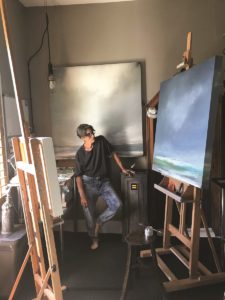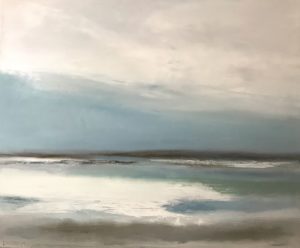Since Lorraine DeProspo moved to Provincetown year-round almost two years ago — for nearly two decades, she split her time between here and Montclair, N.J. — she has noticed a transformation in her art. “I now understand the rhythms of the sea and sky, how the temperament of the water changes so quickly,” DeProspo says. “I don’t think I had a choice about coming here. I had to be here.”
Just as the sea beckoned DeProspo to Provincetown, her work draws the viewer in, almost hypnotically, to a place of tempestuousness or, alternatively, tranquility. She is represented by Outermost Home gallery, at 427 Commercial St. in Provincetown, where her work can be seen in the flesh.

DeProspo observes that just as the Provincetown community changes from summer to winter, so does the sea. “There are different colors, there is a different feel, there is a whole different vibe during the wintertime,” she says. Not to mention the day-to-day variability of Outer Cape weather, she adds, which can have an enormous effect on mood.
DeProspo began as a ceramic artist. As an undergraduate, she had very little interest in painting. “I thought three-dimensionally,” she says. “I still can’t draw very well.” But when she was done with school and struck out on her own, without easy access to tools or a studio, she realized that her medium needed to change. Her partner at the time encouraged her to paint: “One day I came home, and there was an easel in our spare room,” she says.
That got her started. “I bought the biggest canvas I could find — a four-foot canvas,” she says. “I made a lot of mud. I didn’t know how to mix colors, but I knew the colors I wanted to work in, and they were all earth tones. They were all grays, every combination of gray: brown-gray, green-gray, gray-gray, 50 shades of gray.”
Before long, DeProspo found that when she visited museums or galleries, she would walk past the Giacometti sculptures and gravitate to such artists as Mark Rothko, Gerhard Richter, and Helen Frankenthaler. “I was amazed by how she could pour paint on canvas and have it become such a beautiful thing,” DeProspo says of Frankenthaler. “Which I actually tried to do in my tiny little studio and ruined my hardwood floor.”

An artist that DeProspo was compared to early on was J.M.W. Turner. Not having much of an art-historical background, DeProspo had to look up who he was. “To say that my work is ‘Turner-esque’ — I should have known that was a really big compliment and bought that person a drink.” Yet the comparison is apt, especially considering Turner’s proto-abstract style.
DeProspo’s method is largely intuitive and self-taught. She paints on canvases of varying shapes and sizes, ranging from a square foot to larger than four square feet. “I predominantly use palette knives,” she says. “Sometimes, I’ll use a nail or something else that I dig up on the beach. Sometimes a squeegee. And I use my hands a lot, almost like a finger painter.”
Another aspect of DeProspo’s work is the cold wax she adds to her paint. “It gives a very buttery experience to the paint,” she says. “It is not at all like encaustic.” It dries completely matte and is soft to the touch. By layering and blending thin layers of this paint, she’s able to emulate fog and sea spray. “Fog is my favorite thing, because it is so elusive,” she says. “One minute it’s there, one minute it’s not. What color is it?”
DeProspo has noticed that living in Provincetown changed her color palette. “All of a sudden, I’ve shifted to blue tones that don’t necessarily have a lot of gray in them, which I never painted with before I moved here,” she says. “It’s because, when I look out my window, I have the harbor right in front of me. Every day, that’s what I see. I see the water; I see the sky. I have been enveloped by blue.”

She does not paint from life. Though she takes photographs, they are mostly used as a reference for mixing colors. “It’s a remembrance — it’s not something I am looking at right now,” she says of her art. “It is something I looked at two days ago, three weeks ago, maybe five months ago, and it is just sort of floating in my head and bubbles its way to the surface.”
As DeProspo paints her imaginary skyscapes and seascapes, she’s focused on color, texture, and strong horizontals. She categorizes her work as somewhere in the middle of the abstract-realistic continuum. “I’m certainly not abstract, per se, but I like to think that I am leaning towards the abstract,” she says.
She’s seeking something beyond an objective view. “I don’t want to look out the window and paint what I see,” DeProspo says. “I want to paint what I feel.”



